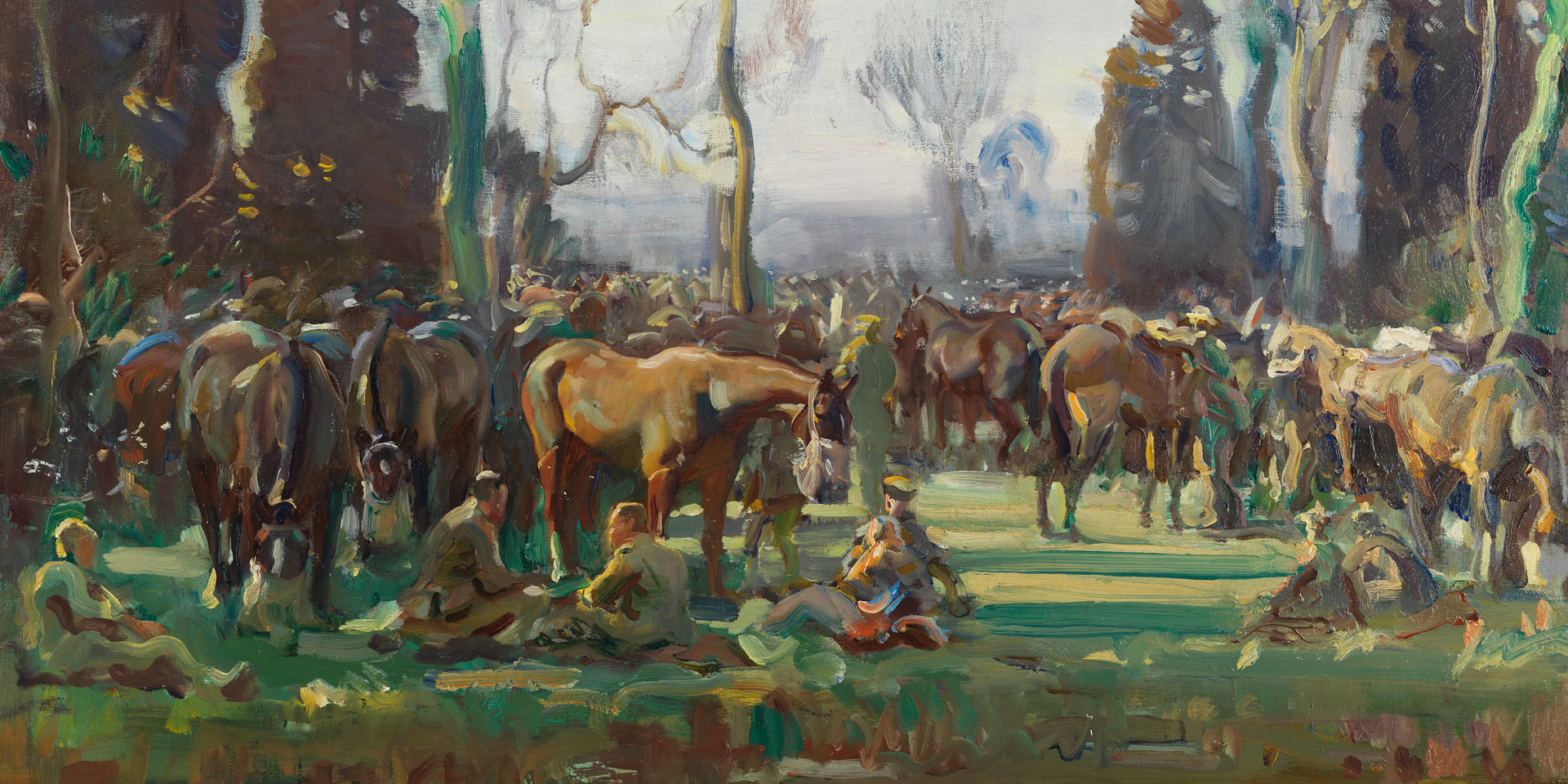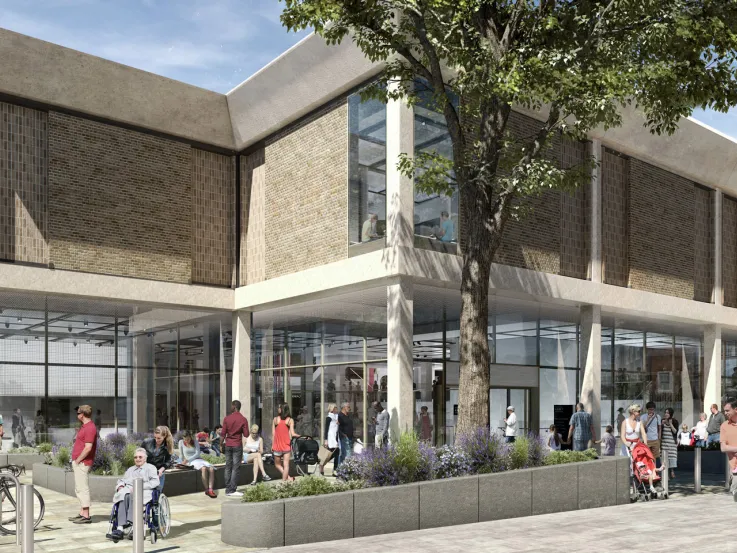Collection of Sir Alfred Munnings' paintings returns to England for first time since 1919

Halt on the March by a Stream at Nesle (Beaverbrook Collection of War Art, Canadian War Museum)
From 30 November 2018 to 3 March 2019, the National Army Museum will exhibit the work of Sir Alfred Munnings (1878-1959) in 'Alfred Munnings: War Artist, 1918'.
The exhibition, developed by the Canadian War Museum (Ottawa, Canada) in partnership with The Munnings Art Museum (Dedham, UK) and generously supported by The Beaverbrook Canadian Foundation, will display over 40 paintings created during the final year of the First World War, shown together for the first time since 1919.
Covering a number of themes the exhibition shows Munnings' emerging mastery of equine subjects, portraiture and pastoral landscapes. Munnings' wartime artwork displays the skill that led to him securing admittance to the Royal Academy of Arts in 1919 and contributed to his role as one of Britain's most celebrated equine artists. The exhibition is locally supported by Juddmonte and supplemented with works from the National Army Museum's own collection relating to General Jack Seely, who commanded the Canadian Cavalry Brigade throughout much of the war.
Munnings was commissioned by the Canadian War Memorials Fund as an official war artist, to capture the fighting front and the crucial logistical work behind the lines. In early 1918, he was embedded with the Canadian Expeditionary Force, an army comprised largely of citizen soldiers fighting on the Western Front. The Canadian War Memorials Fund was created by Lord Beaverbrook to document and memorialise the Canadian war effort at home and overseas through paintings and sculpture.
'It is a pleasure to share works by Alfred Munnings with an international audience,' said Mark O'Neill, President and CEO of the Canadian War Museum and Canadian Museum of History. 'His paintings of First World War scenes - from the men and horses who served in wartime, to forests and battlefields - are an evocative reflection not only of Canada's military history, but the development of one of England's best-known artists.'
'The Beaverbrook Canadian Foundation is delighted to bring this important collection of Munnings' art to the UK for the first time. My great grandfather commissioned many artists to capture the emotion of the First World War. One of the most important among these was Alfred Munnings, who produced evocative images of the Canadian Cavalry Brigade and the Canadian Forestry Corps, which can be seen in this exhibition. We are pleased that this extraordinary collection will be able to be seen by a new audience at the National Army Museum,' said Max Aitken, President of The Beaverbrook Canadian Foundation.
Justin Maciejewski, Director of the National Army Museum commented, 'We are delighted to be the first venue for this tour of paintings from the Canadian War Museum. The 41 canvases by Alfred Munnings are part of Canada's memorial to those who served during the First World War. They are amongst the best work by the artist and, exhibited together, they tell an evocative story of service and sacrifice by both soldiers and horses.'
Douglas Erskine Crum, CEO Juddmonte Group, added, 'Juddmonte is delighted to support this unique showcase of works by one of our country's finest equine artists. Munnings is well known for his paintings of racehorses, but this new exhibition provides members of the British public a first chance to enjoy his wonderful studies of the First World War.'
The exhibition will be accompanied by a book edited by Dr Jonathan Black, 'Alfred Munnings: Memory, The War Horse and the Canadians in 1918', and a public programme at the National Army Museum. Tickets can be booked in advance at www.nam.ac.uk/munnings and cost £6 (plus concessions).
Notes to editors
For more information, please contact Claire Blackshaw at cblackshaw@nam.ac.uk or 020 7881 2433.
- Opening hours: 10am - 5.30pm (Monday - Sunday), 10am - 8pm (first Wednesday of every month, but please check the website for alternative late night dates in December 2018 and January 2019)
- Tickets: £6 adult, £5 concession, £4 group, under 16 free
- General admittance to Museum is free.
Join in the conversation:
- Twitter: @NAM_London
- Facebook: facebook.com/NationalArmyMuseum
- Instagram: @NAM_London
- Hashtag: #Munnings
About Sir Alfred Munnings
Sir Alfred James Munnings (1878-1959) achieved renown as one of Britain's finest painters of horses. During the First World War his engagement by Lord Beaverbrook's Canadian War Memorials Fund led to a series of prestigious post-war commissions.
Alfred Munnings was born into a miller's family at Mendham, Suffolk, on 8 October 1878. At 14 he was apprenticed to a Norwich printer and attended the Norwich School of Art. He lost sight in his right eye in 1898 at the age of 20, when a bramble sprang back into his eye whilst lifting a hound puppy over a stile.
From 1899 Munnings began to earn a living as a painter and had his works accepted for the Royal Academy of Arts' Summer Exhibition every year thereafter. At the outbreak of the First World War Munnings attempted to sign-up with a number of regiments but was unsuccessful due to his poor eyesight. In 1917, he managed to secure a position with the Army examining horses at Calcot Park, near Reading in Berkshire, where horses were checked for diseases and parasites, before being sent off to artillery, cavalry, or supply units.
Munnings was then asked to join the Canadian War Memorials Fund art programme in 1918 and was assigned to paint the Canadian Cavalry Brigade and Canadian Forestry Corps. His first work for the fund was an equestrian portrait of the commander of the brigade, General the Right Honourable JEB Seely, painted less than a mile from the front line.
The artist considered his experiences with Canadian units to have been among the most rewarding events of his life. He believed that when Richard Jack (the British painter who had been the first artist hired by Lord Beaverbrook) sponsored him for associate membership in the Royal Academy in the spring of 1919, it was due to his contributions to the Canadian War Memorials Fund.
Munnings was elected president of the Royal Academy of Arts in 1944 and received a knighthood from King George VI the same year. Following his death in 1959, his second wife, Violet, helped turn their home into a museum of his works, which is known today as The Munnings Art Museum. Sir Alfred's ashes are interred at St Paul's Cathedral, London.
About the National Army Museum
The National Army Museum is the leading authority on the history of our Army. Founded in 1960 by Royal Charter and established for the purpose of collecting, preserving and exhibiting objects and records relating to the Land Forces of the British Crown, it is a museum that inspires, engages and educates. The Museum seeks to tell the story of our Army, the personal experiences of the soldiers who have served in it and to connect the public and its Army, demonstrating how the role of the Army and its actions are still relevant today.
About The Beaverbrook Canadian Foundation
As part of his legacy Lord Beaverbrook set up two charitable Foundations bearing his name. The Beaverbrook Canadian Foundation, established in 1960, is a charitable foundation located in Montreal, Quebec and is proud to support selected organisations, predominantly in New Brunswick, in the areas of education, the arts and culture. Together with The Beaverbrook Foundation, based in the UK, the Foundations have made donations to over 900 charities in the last 60 years.
About the Canadian War Museum
The Canadian War Museum is Canada’s national museum of military history. Its mission is to promote public understanding of Canada’s military history in its personal, national and international dimensions. Work of the Canadian War Museum is made possible in part through financial support of the Government of Canada.
About The Munnings Art Museum
The Munnings Art Museum is at Castle House, the former home and working studio of Sir Alfred Munnings in Dedham, Essex. After Munnings’ death in 1959 the house, with all its contents, was opened as an art museum by his widow, Violet, Lady Munnings. Today, the museum presents changing displays of the artist’s life work as well as special themed exhibitions.
About Juddmonte
Juddmonte is one of the world’s leading breeders of thoroughbred horses, and has to date bred over 100 individual Group/Grade 1 winners of over 200 Group/Grade 1 races, including 25 Classic winners. All its homebred progeny are raced in Khalid Abdullah’s famous green, pink and white colours. Juddmonte has farms in the UK, Ireland and the USA, standing its European stallions at Banstead Manor Stud near Newmarket, England, and its US stallions in Kentucky, USA. Its current roster of stallions includes world champions Frankel, the highest rated horse since records began, and Arrogate, the highest earner in horseracing history.

